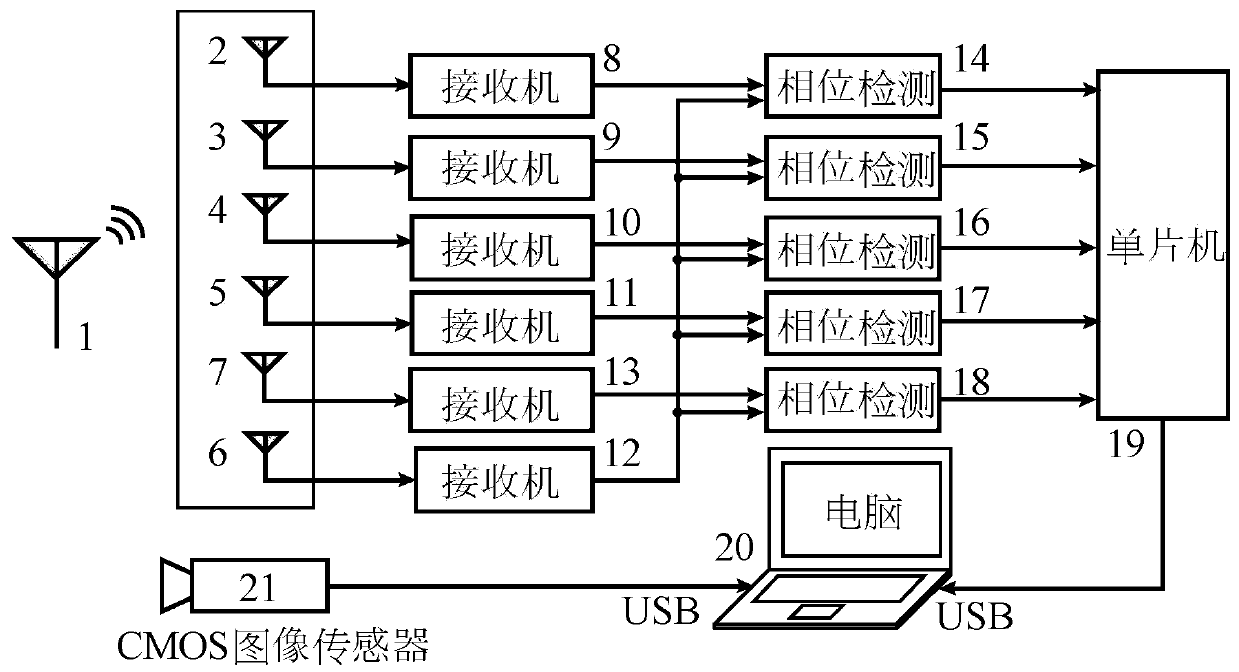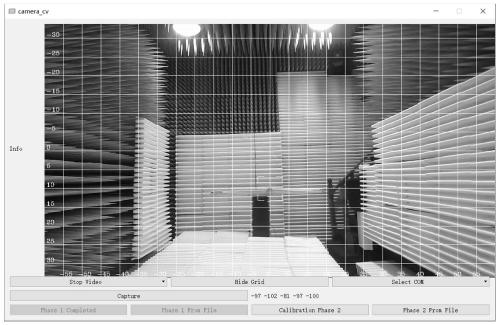Measurement method based on visual array antenna
A technology of an array antenna and a measurement method, which is applied to a radio wave measurement system, a direction finder using radio waves, a measurement device, etc., can solve the problems of separation of coupled components, difficulty in achieving effective positioning, and difficulty in precise positioning.
- Summary
- Abstract
- Description
- Claims
- Application Information
AI Technical Summary
Problems solved by technology
Method used
Image
Examples
Embodiment 1
[0058] Embodiment 1 adopts figure 1 , figure 2 and image 3 The direction finding system shown demonstrates the first method of direction finding.
[0059] image 3 The software calibration platform shown also has direction finding capabilities. After obtaining the calibration data corresponding to all grid points, when using the software calibration platform for actual positioning, whenever the signal source moves to a certain image position, the signal phase detection system automatically detects the phase difference information, as shown in the figure -97 102-81-97 -100. The measured phase difference information and all the phase difference information in the calibration data are calculated one by one using the correlation coefficient formula. When the calculated correlation coefficient is the largest, the corresponding viewing angle coordinates is the image position where the signal source is located, such as image 3 The position indicated by the square cursor in ...
Embodiment 2
[0061] Embodiment 2 adopts figure 1 , figure 2 and image 3 The direction finding system shown and Figure 4 The shown neural network structure demonstrates the second direction finding method.
[0062] After obtaining the calibration data corresponding to all grid points, the backpropagation algorithm can be used to optimize the establishment of Figure 4 The neural network shown. The input of the neural network is the phase difference information, and the output is the viewing angle coordinates The calculated value of . Figure 4 The operation process from left to right can be regarded as the forward propagation process of the neural network. In the forward propagation process, the phase difference information is input, and the calculated viewing angle coordinates for output. In this embodiment, the backpropagation algorithm is to calculate the viewing angle coordinates based on the phase difference information of the calibration data Corresponding viewing angle...
Embodiment 3
[0065] Embodiment 3 adopts figure 1 , figure 2 and image 3 The direction finding system shown and Figure 6 The shown neural network structure demonstrates the second direction finding method.
[0066] After obtaining the calibration data corresponding to all grid points, the viewing angle coordinates The incident angle of the electromagnetic wave signal can be obtained by using the coordinate transformation principle according to the positional relationship between the CMOS image sensor and the array antenna angle of incidence Can be used to form a complex vector I' constructed based on phase difference information as input in a neural network n and as output a complex vector V constructed based on the coordinate information n .
[0067] Figure 6 The operation process from left to right in can be regarded as the forward propagation process of the neural network. In this embodiment, the backpropagation algorithm uses the calculation error of each forward propaga...
PUM
 Login to View More
Login to View More Abstract
Description
Claims
Application Information
 Login to View More
Login to View More - R&D
- Intellectual Property
- Life Sciences
- Materials
- Tech Scout
- Unparalleled Data Quality
- Higher Quality Content
- 60% Fewer Hallucinations
Browse by: Latest US Patents, China's latest patents, Technical Efficacy Thesaurus, Application Domain, Technology Topic, Popular Technical Reports.
© 2025 PatSnap. All rights reserved.Legal|Privacy policy|Modern Slavery Act Transparency Statement|Sitemap|About US| Contact US: help@patsnap.com



